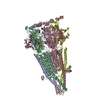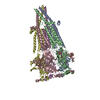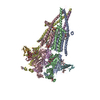+ Open data
Open data
- Basic information
Basic information
| Entry | Database: PDB / ID: 9avv | ||||||
|---|---|---|---|---|---|---|---|
| Title | Bovine adult muscle nAChR resting state | ||||||
 Components Components |
| ||||||
 Keywords Keywords | MEMBRANE PROTEIN / Bovine muscle nicotinic acetylcholine receptor | ||||||
| Function / homology |  Function and homology information Function and homology informationHighly sodium permeable postsynaptic acetylcholine nicotinic receptors / Highly calcium permeable postsynaptic nicotinic acetylcholine receptors / Highly calcium permeable nicotinic acetylcholine receptors / postsynaptic membrane organization / skeletal muscle tissue growth / musculoskeletal movement / neuromuscular synaptic transmission / acetylcholine-gated channel complex / behavioral response to nicotine / muscle cell development ...Highly sodium permeable postsynaptic acetylcholine nicotinic receptors / Highly calcium permeable postsynaptic nicotinic acetylcholine receptors / Highly calcium permeable nicotinic acetylcholine receptors / postsynaptic membrane organization / skeletal muscle tissue growth / musculoskeletal movement / neuromuscular synaptic transmission / acetylcholine-gated channel complex / behavioral response to nicotine / muscle cell development / acetylcholine receptor activity / synaptic transmission, cholinergic / acetylcholine binding / postsynaptic specialization membrane / acetylcholine receptor signaling pathway / nervous system process / channel activity / acetylcholine-gated monoatomic cation-selective channel activity / neuromuscular junction development / muscle cell cellular homeostasis / monoatomic cation transport / membrane depolarization / skeletal muscle contraction / neuronal action potential / muscle contraction / transmitter-gated monoatomic ion channel activity involved in regulation of postsynaptic membrane potential / response to nicotine / neuromuscular junction / neuron cellular homeostasis / postsynaptic membrane / neuron projection / synapse / cell surface / signal transduction / plasma membrane Similarity search - Function | ||||||
| Biological species | synthetic construct (others) | ||||||
| Method | ELECTRON MICROSCOPY / single particle reconstruction / cryo EM / Resolution: 2.09 Å | ||||||
 Authors Authors | Li, H. / Hibbs, R.E. | ||||||
| Funding support |  United States, 1items United States, 1items
| ||||||
 Citation Citation |  Journal: Nature / Year: 2024 Journal: Nature / Year: 2024Title: Structural switch in acetylcholine receptors in developing muscle Authors: Li, H. / Teng, J.F. / Hibbs, R.E. | ||||||
| History |
|
- Structure visualization
Structure visualization
| Structure viewer | Molecule:  Molmil Molmil Jmol/JSmol Jmol/JSmol |
|---|
- Downloads & links
Downloads & links
- Download
Download
| PDBx/mmCIF format |  9avv.cif.gz 9avv.cif.gz | 822.3 KB | Display |  PDBx/mmCIF format PDBx/mmCIF format |
|---|---|---|---|---|
| PDB format |  pdb9avv.ent.gz pdb9avv.ent.gz | 697.9 KB | Display |  PDB format PDB format |
| PDBx/mmJSON format |  9avv.json.gz 9avv.json.gz | Tree view |  PDBx/mmJSON format PDBx/mmJSON format | |
| Others |  Other downloads Other downloads |
-Validation report
| Summary document |  9avv_validation.pdf.gz 9avv_validation.pdf.gz | 1.9 MB | Display |  wwPDB validaton report wwPDB validaton report |
|---|---|---|---|---|
| Full document |  9avv_full_validation.pdf.gz 9avv_full_validation.pdf.gz | 1.9 MB | Display | |
| Data in XML |  9avv_validation.xml.gz 9avv_validation.xml.gz | 79.6 KB | Display | |
| Data in CIF |  9avv_validation.cif.gz 9avv_validation.cif.gz | 118 KB | Display | |
| Arichive directory |  https://data.pdbj.org/pub/pdb/validation_reports/av/9avv https://data.pdbj.org/pub/pdb/validation_reports/av/9avv ftp://data.pdbj.org/pub/pdb/validation_reports/av/9avv ftp://data.pdbj.org/pub/pdb/validation_reports/av/9avv | HTTPS FTP |
-Related structure data
| Related structure data |  43924MC  9avuC  9awjC  9awkC M: map data used to model this data C: citing same article ( |
|---|---|
| Similar structure data | Similarity search - Function & homology  F&H Search F&H Search |
- Links
Links
- Assembly
Assembly
| Deposited unit | 
|
|---|---|
| 1 |
|
- Components
Components
-Acetylcholine receptor subunit ... , 4 types, 5 molecules ACEDB
| #1: Protein | Mass: 49949.828 Da / Num. of mol.: 2 / Source method: isolated from a natural source / Source: (natural)  #2: Protein | | Mass: 55111.832 Da / Num. of mol.: 1 / Source method: isolated from a natural source / Source: (natural)  #3: Protein | | Mass: 56543.926 Da / Num. of mol.: 1 / Source method: isolated from a natural source / Source: (natural)  #4: Protein | | Mass: 52613.262 Da / Num. of mol.: 1 / Source method: isolated from a natural source / Source: (natural)  |
|---|
-Protein / Non-polymers , 2 types, 10 molecules FG

| #10: Chemical | ChemComp-POV / ( #5: Protein | Mass: 6993.089 Da / Num. of mol.: 2 Source method: isolated from a genetically manipulated source Source: (gene. exp.) synthetic construct (others) / Production host:  |
|---|
-Sugars , 5 types, 7 molecules 
| #6: Polysaccharide | alpha-D-mannopyranose-(1-2)-alpha-D-mannopyranose-(1-3)-[alpha-D-mannopyranose-(1-2)-alpha-D- ...alpha-D-mannopyranose-(1-2)-alpha-D-mannopyranose-(1-3)-[alpha-D-mannopyranose-(1-2)-alpha-D-mannopyranose-(1-6)]alpha-D-mannopyranose-(1-6)-[alpha-D-mannopyranose-(1-2)-alpha-D-mannopyranose-(1-3)]beta-D-mannopyranose-(1-4)-2-acetamido-2-deoxy-beta-D-glucopyranose-(1-4)-2-acetamido-2-deoxy-beta-D-glucopyranose Type: oligosaccharide / Mass: 1721.527 Da / Num. of mol.: 1 Source method: isolated from a genetically manipulated source | ||||||
|---|---|---|---|---|---|---|---|
| #7: Polysaccharide | Source method: isolated from a genetically manipulated source #8: Polysaccharide | alpha-D-mannopyranose-(1-2)-alpha-D-mannopyranose-(1-2)-alpha-D-mannopyranose-(1-3)-[alpha-D- ...alpha-D-mannopyranose-(1-2)-alpha-D-mannopyranose-(1-2)-alpha-D-mannopyranose-(1-3)-[alpha-D-mannopyranose-(1-2)-alpha-D-mannopyranose-(1-3)-[alpha-D-mannopyranose-(1-2)-alpha-D-mannopyranose-(1-6)]alpha-D-mannopyranose-(1-6)]beta-D-mannopyranose-(1-4)-2-acetamido-2-deoxy-beta-D-glucopyranose-(1-4)-2-acetamido-2-deoxy-beta-D-glucopyranose | Source method: isolated from a genetically manipulated source #9: Polysaccharide | alpha-D-mannopyranose-(1-3)-alpha-D-mannopyranose-(1-6)-[alpha-D-mannopyranose-(1-3)]beta-D- ...alpha-D-mannopyranose-(1-3)-alpha-D-mannopyranose-(1-6)-[alpha-D-mannopyranose-(1-3)]beta-D-mannopyranose-(1-4)-2-acetamido-2-deoxy-beta-D-glucopyranose-(1-4)-2-acetamido-2-deoxy-beta-D-glucopyranose | Source method: isolated from a genetically manipulated source #11: Sugar | |
-Details
| Has ligand of interest | Y |
|---|
-Experimental details
-Experiment
| Experiment | Method: ELECTRON MICROSCOPY |
|---|---|
| EM experiment | Aggregation state: PARTICLE / 3D reconstruction method: single particle reconstruction |
- Sample preparation
Sample preparation
| Component | Name: Bovine muscle nicotinic acetylcholine receptor / Type: COMPLEX / Entity ID: #1-#5 / Source: MULTIPLE SOURCES |
|---|---|
| Molecular weight | Experimental value: NO |
| Source (natural) | Organism:  |
| Buffer solution | pH: 7.4 |
| Specimen | Embedding applied: NO / Shadowing applied: NO / Staining applied: NO / Vitrification applied: YES |
| Vitrification | Cryogen name: ETHANE |
- Electron microscopy imaging
Electron microscopy imaging
| Experimental equipment |  Model: Titan Krios / Image courtesy: FEI Company |
|---|---|
| Microscopy | Model: FEI TITAN KRIOS |
| Electron gun | Electron source:  FIELD EMISSION GUN / Accelerating voltage: 300 kV / Illumination mode: OTHER FIELD EMISSION GUN / Accelerating voltage: 300 kV / Illumination mode: OTHER |
| Electron lens | Mode: BRIGHT FIELD / Nominal defocus max: 2200 nm / Nominal defocus min: 1600 nm |
| Image recording | Electron dose: 50 e/Å2 / Film or detector model: FEI FALCON III (4k x 4k) |
- Processing
Processing
| CTF correction | Type: PHASE FLIPPING AND AMPLITUDE CORRECTION |
|---|---|
| 3D reconstruction | Resolution: 2.09 Å / Resolution method: FSC 0.143 CUT-OFF / Num. of particles: 209258 / Symmetry type: POINT |
| Atomic model building | Protocol: AB INITIO MODEL / Space: REAL |
| Atomic model building | Details: cryosparc ab initial model / Source name: Other / Type: experimental model |
 Movie
Movie Controller
Controller






 PDBj
PDBj



